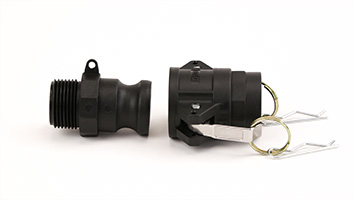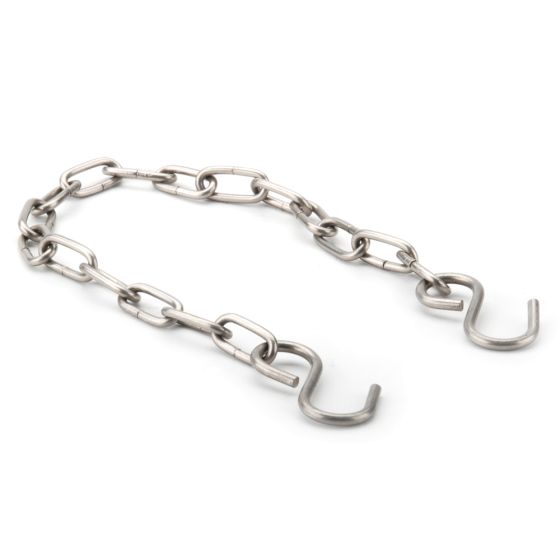- Home
- Hose, Tube & Fittings
- Hose Fittings
- Camlock Hose Fittings
Camlock Hose Fittings
What Are Camlock Hose Fittings?
Camlock hose fittings, also known as Cam-and-Groove Couplings, are quick-connect systems designed for securely and efficiently joining hoses or pipes. They enable the fast and reliable transfer of fluids, powders, or gases across a wide range of industrial applications.
Renowned for their simplicity, Camlock fittings require no tools for assembly or disassembly, making them ideal for operations where hoses are frequently connected and disconnected. With a variety of sizes and materials available, these fittings offer versatility, durability, and compatibility with diverse environments, including agriculture, food processing, chemical handling, and construction.
What Are The Key Features of Camlock Hose Fittings?
- Quick and Easy Operation: Enable swift connections and disconnections, enhancing operational efficiency.
- Versatility: Available in various materials and sizes to suit different applications and media.
- Reliability: Designed to provide secure, leak-proof connections under various operating conditions.
- Cost-Effectiveness: Their durability and reusability contribute to long-term savings.
Materials & Applications
Camlock hose fittings are manufactured from various materials, each offering distinct properties tailored to specific applications. Here's an overview of the common materials used and their typical uses:
Polypropylene (Poly) Camlock Fittings
- Properties: Lightweight and cost-effective, with good chemical resistance.
- Applications: Commonly used in agriculture for irrigation and water transfer, as well as in chemical applications where metal fittings may corrode.
Aluminium Camlock Fittings
- Properties: Lightweight with good corrosion resistance.
- Applications: Ideal for general-purpose use, including the transfer of water and petroleum products. Their lightweight makes them suitable for applications where ease of handling is important.
Brass Camlock Fittings
- Properties: Durable with good corrosion resistance, especially in saltwater environments.
- Applications: Suitable for water, hydraulic oil, coolants, and petrol transfer. Commonly used in marine settings and industries requiring reliable performance under moderate conditions.
Stainless Steel Camlock Fittings
- Properties: High strength and excellent resistance to corrosion and high temperatures.
- Applications: Preferred in demanding environments such as the food, chemical, and pharmaceutical industries, where hygiene and durability are critical.
What Are The Types of Camlock Hose Fittings?
Camlock Hose Fittings are available in a range of types to accommodate various connection requirements. These fittings are classified into different types, denoted by letters (A, B, C, D, E, F, DC, and DP). Each type serves a specific purpose, allowing you to customise your setup to suit your application. Here's a breakdown of the different Camlock Hose Fitting types:
Type A
- Description: Male adapter with a female thread.
- Use: Ideal for connecting a male thread to a hose coupling.
Type B
- Description: Female coupler with a male thread.
- Use: Commonly used to connect hoses to threaded pipes or tanks.
Type C
- Description: Female coupler with a hose tail.
- Use: Designed for attaching hoses securely to a male adapter.
Type D
- Description: Female coupler with a female thread.
- Use: Perfect for connecting a male-threaded fitting or pipe to a hose system.
Type E
- Description: Male adapter with a hose tail.
- Use: Used to attach hoses to a female coupler.
Type F
- Description: Male adapter with a male thread.
- Use: Commonly used for connecting hoses to female-threaded fittings.
Type DC (Dust Cap)
- Description: A cap for sealing the end of a female coupler.
- Use: Protects the coupling from contamination when not in use.
Type DP (Dust Plug)
- Description: A plug for sealing the end of a male adapter.
- Use: Prevents debris or contaminants from entering the system during downtime.
How Do You Use Camlock Fittings?
Connection Process
- Prepare the Coupler and Adapter
- Start with the female fitting’s cam arms (handles) raised to the sides.
- Align the male adapter with the opening of the female coupler.
- Insert and Engage
- Insert the male adapter into the female coupler.
- Simultaneously close both cam arms to lock the two fittings together. This action compresses the gasket inside the female coupler, creating a secure and leak-proof seal.
- Ensure both arms are closed at the same time for an even seal, preventing leaks or uneven pressure.
- Lock In Place
- Insert the pins into the slots to lock the cam arms, ensuring a safe seal.
Disconnection Process
- Depressurize the Assembly
- Before disconnecting, always depressurize the system to avoid accidents or spills.
- Disengage the Arms
- Remove Pins to unlock the cam arms
- Pull the cam arms outward to release the male adapter and break the seal.
- Remove the Male Adapter
- Once the arms are fully open, the male adapter can be easily removed.








Maintenance Tips for Camlock Fittings
- Operate Within Design Limits
- Always use Camlock fittings within their specified pressure and temperature ranges.
- Avoid exceeding these limits to reduce the risk of failure or safety issues.
- Check Connections Securely
- Verify that the coupling arms are properly locked and all connections are tight before starting operations.
- Align male and female components correctly to ensure a leak-free fit.
- Select Compatible Materials
- Use Camlock fittings made from materials suitable for the fluid being handled.
- Choose materials that resist chemical reactions or degradation in your operating environment.
- Handle with Caution
- While durable, Camlock fittings can be damaged by rough handling.
- Store and handle them carefully to prevent scratches, dents, or contamination.
- Provide Adequate Training
- Ensure all personnel working with Camlock fittings understand their proper use and associated safety measures.
- Regular training reduces the risk of improper handling.
- Conduct Regular Inspections
- Frequently examine your Camlock fittings for signs of wear, damage, or corrosion.
- Check that the locking arms function correctly and inspect seals for any cracks or wear.
- Replace Gaskets as Needed
- Change gaskets periodically to maintain a secure seal and prevent leaks.
- Keep a stock of compatible gaskets to ensure timely replacements.
- Depressurise Before Disconnecting
- Ensure the system is fully depressurised before disconnecting fittings.
- This step helps prevent accidental fluid release or pressure-related hazards.
- Prevent Cross-Threading
- When threading fittings, take care to avoid cross-threading to protect the threads and maintain a secure seal.
- Establish Emergency Protocols
- Develop clear procedures for dealing with leaks, disconnections, or equipment failures.
- Equip staff with the knowledge and tools to address emergencies effectively.
If you require any further information, our excellent customer service team is here to help so please call us on 01794 835835.









